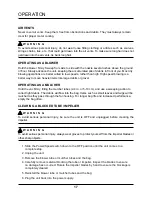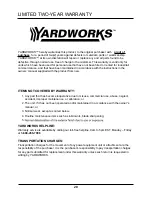
5
SPECIfIC SAfETY RULES fOR BLOWER
•
Make sure your extension cord is in good condition. When using an extension cord, be sure to
use one heavy enough to carry the current your product will draw. A wire gauge size (A.W.G.)
of at least 14 is recommended for an extension cord 50 feet or less in length. If in doubt, use
the next heavier gauge. The smaller the gauge number, the heavier the cord. An undersized
cord will cause a drop in line voltage resulting in loss of power and overheating.
•
Do not point the blower nozzle in the direction of people or pets.
•
never run the unit without the proper equipment attached. Always ensure the blower tubes are
installed.
•
When not in use, blower should be stored indoors in a dry, locked up place—out of the reach of
children.
•
Maintain tool with care. Keep fan area clean for best and safest performance. follow
instructions for proper maintenance.
• Do not attempt to clear clogs from tool without first unplugging it.
•
Do not pull or carry by cord,
do not
use cord as a handle, or
do not
pull cord around sharp
edges or corners Keep cord away from heated surfaces.
•
Do not unplug by pulling on cord. To unplug, grasp the plug, not the cord.
•
To reduce the risk of electrical shock, do not expose to rain, do not use on wet surfaces. Store
indoors.
•
If the power supply cord is damaged, it must be replaced only by the manufacturer or by an
authorized service center to avoid risk.
•
Extension Cord – To reduce the risk of disconnection of appliance cord from the extension
cord during operating, it is possible to tie the extension cord and power cord in a knot to
prevent them from becoming disconnected during use. Make the knot as shown in figure 1,
then connect the plug end of the power cord into the receptacle end of the extension cord. This
method can also be used to tie two extension cords together.
Fig. 1
Summary of Contents for 267-2929
Page 21: ...21 EXPLODED VIEW...






































